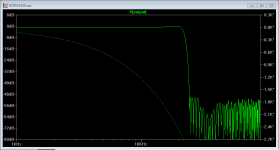Filter replacement project
Awesome... Keep us posted on your progress. 😀I've ordered up some development boards today to kick this filter project back into life. Instead of the LPC5411x chip I've discovered a simpler solution (I hope!) using an STM32F071 or -072. I'll post updates to my blog - that is unless there's a strong demand for a dedicated thread.
http://www.diyaudio.com/forums/blogs/abraxalito/1375-saa7220-filter-replacement-project.html
Glad there's still some interest - last night I recovered the source code for the filter from my old laptop that died (had to yank out the HDD and stick it in a dedicated USB box), so there's a little bit of progress.
STM32xxxx isn't that the same processor-family Arduino uses?I've ordered up some development boards today to kick this filter project back into life. Instead of the LPC5411x chip I've discovered a simpler solution (I hope!) using an STM32F071 or -072. I'll post updates to my blog - that is unless there's a strong demand for a dedicated thread.
http://www.diyaudio.com/forums/blogs/abraxalito/1375-saa7220-filter-replacement-project.html
Well, I'd love to be updated to your progress...
I had to update myself on Arduino - originally it was just a lowish powered 8bit micro from Atmel that Arduino was based on. But now it seems its embraced ARM chips but I'm not totally sure how official that is - the Arduino IDE can be used with ARM chips as Arduino sketches are written in C.
It works!
Hi, I tried the SM5814 in my Curcio DAC. The best results I got with a CS8412 DIR with Wildmonkeysects loop filter and a MAX913 at the input.
Thank you Torchwood, also for correcting the typo's in the datasheet.
Hi, I tried the SM5814 in my Curcio DAC. The best results I got with a CS8412 DIR with Wildmonkeysects loop filter and a MAX913 at the input.
Thank you Torchwood, also for correcting the typo's in the datasheet.
My boards works well, but there was a couple of things to fix on them and the DIP footprint was too narrow. I did design these in my rookie-to-eager-to-tripple-check-things stage of PCB design.
So not really an improvement over doing the board on perf board.
Today, I'd use U.FL connectors for the I2S signals amongst other things.
So not really an improvement over doing the board on perf board.
Today, I'd use U.FL connectors for the I2S signals amongst other things.
Alternate to SAA7220

I am glad you found it useful. It sounds better then any 7220 for sure. My cousin gets all the credit for this one. He discovered this part all those years ago.Hi, I tried the SM5814 in my Curcio DAC. The best results I got with a CS8412 DIR with Wildmonkeysects loop filter and a MAX913 at the input.
Thank you Torchwood, also for correcting the typo's in the datasheet.

SAA7321 - SAA7323 would provide x4 OS output in I2S format. Haven't tried it yet, but at least one significant advantage is the much lower current consumption of these ICs vs. SAA7220. QFP44 package though...
no one has emulated this in a Rasberry ? http://vasiltech.narod.ru/files/PMD100.pdf
Yes
I find a PMD100 the best of all ICs same purpose.
I think that it can be used even in Time Simoultaneous mode with TDA1541A.
.
little offtopic:
Is there any example of using PMD100 in software mode? Arduino controlled internal register settings maybe?
Thanks 🙂
.
Richard,
thanks for providing the (theoretical) FR of the SAA7220.
Well, I couldn't care less about +-1 dB difference in the region above 16kHz (I reckon the SM5814 neither has the same FR).
Overall, out-of-band attenuation seems to be ~10dB better than with the SAA7220.
Got myself a nice Philips CDF-100, that's where I discovered the mentioned feature (although the CDF uses a lesser SAA7321).
Ordered a 7323 to fit it in a 7220 equipped DAC. Just curious if the OS part of the 7323 would run without the analog parts powered.
Edit: SM5814 doesn't have any FR compensation at all.
thanks for providing the (theoretical) FR of the SAA7220.
Well, I couldn't care less about +-1 dB difference in the region above 16kHz (I reckon the SM5814 neither has the same FR).
Overall, out-of-band attenuation seems to be ~10dB better than with the SAA7220.
Got myself a nice Philips CDF-100, that's where I discovered the mentioned feature (although the CDF uses a lesser SAA7321).
Ordered a 7323 to fit it in a 7220 equipped DAC. Just curious if the OS part of the 7323 would run without the analog parts powered.
Edit: SM5814 doesn't have any FR compensation at all.
Attachments
Last edited:
Yes - the SAA7323 has slightly improved stop-band rejection, I take it this results from the extra 8 taps they were able to include (128 vs 120 for SAA7220).
I'd not expect any FR compensation from those NPC chips as they've not been engineered to be part of a complete system as Philip's chips were.
I'd guess you'd be fine not powering up the analog part - the digital part takes about 200mW which is a big improvement over the 7220 (~900mW). I'm very interested to learn of your subjective results of swapping out the 7220, will you post your listening impressions here?
I'd not expect any FR compensation from those NPC chips as they've not been engineered to be part of a complete system as Philip's chips were.
I'd guess you'd be fine not powering up the analog part - the digital part takes about 200mW which is a big improvement over the 7220 (~900mW). I'm very interested to learn of your subjective results of swapping out the 7220, will you post your listening impressions here?
- Home
- Source & Line
- Digital Line Level
- Alternative to the SAA7220 for TDA1541 dac's

